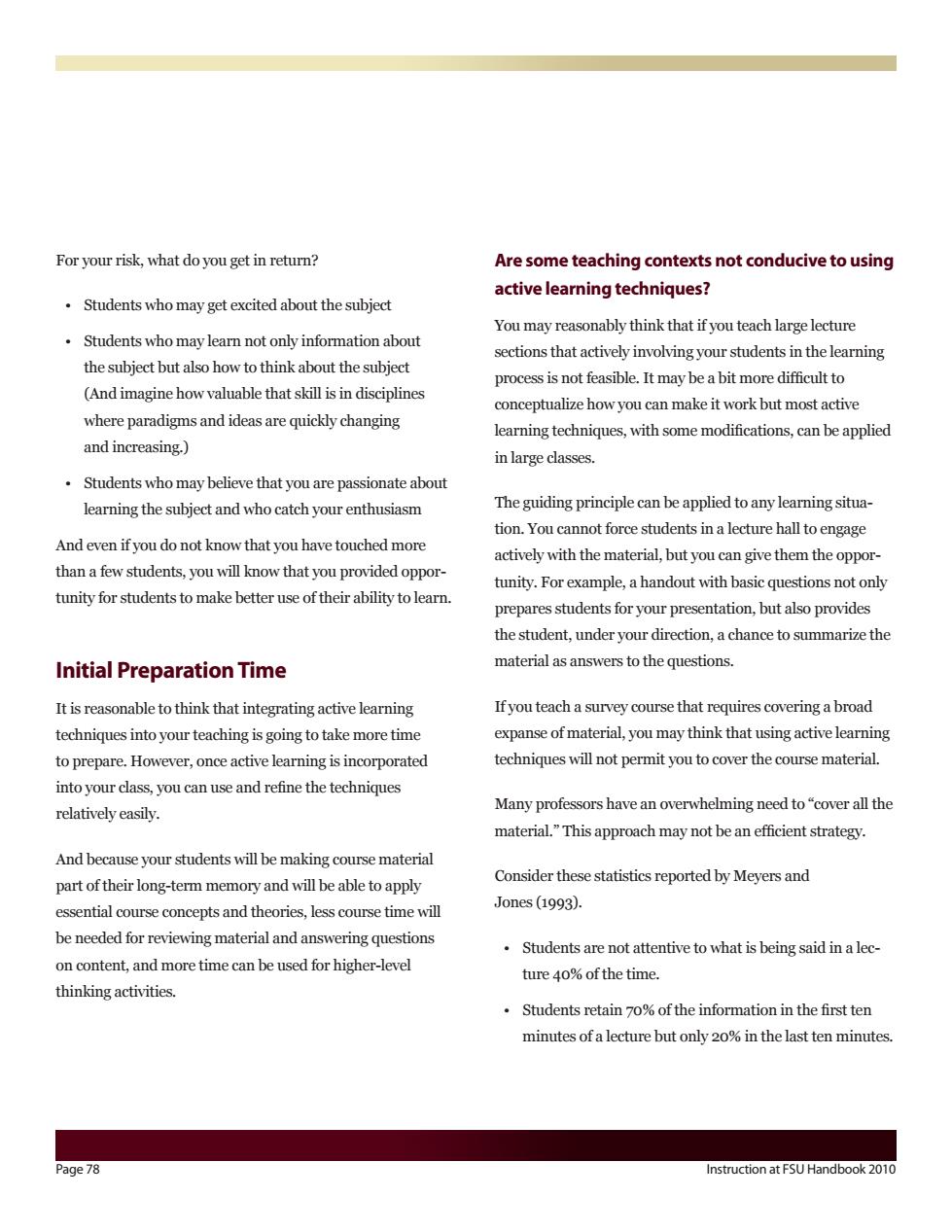正在加载图片...

For your risk,what do you get in return? Are some teaching contexts not conducive to using active learning techniques? Students who may get excited about the subject You may reasonably think that if you teach large lecture Students who may learn not only information about sections that actively involving your students in the learning the subiect but also how to think about the subiect (And imagine how valuable that skill is in disciplines process is not feasible.It may be a bit more difficult to conceptualize how you can make it work but most active where paradigms and ideas are quickly changing learning techniques,with some modifications,can be applied and increasing.) in large classes. Students who may believe that you are passionate about learning the subject and who catch your enthusiasm The guiding principle can be applied to any learning situa- tion.You cannot force students in a lecture hall toengage And even if you do not know that you have touched more actively with the material,but you can give them the oppor- than a few students,you will know that you provided oppor- tunity.For example,a handout with basic questions not only tunity for students to make better use of their ability to learn. prepares students for your presentation,but also provides the student,under your direction,a chance to summarize the Initial Preparation Time material as answers to the questions. It is reasonable to think that integrating active learning If you teach a survey course that requires covering a broad techniques into your teaching is going to take more tim expanse of material,you may think that using active learning to prepare.However,once active learning is incorporated techniques will not permit you to cover the course material into your class,you can use and refine the techniques relatively easilv. Many professors have an overwhelming need to"cover all the material."This approach may not be an efficient strategy And because your students will be making course material Consider these statistics reported by Mevers and part of their long-term memory and will be able to apply essential course concepts and theories,less course time will Jones(1993). be needed for reviewing material and answering questions Students are not attentive to what is being said ina lec- on content,and more time can be used for higher-level ture0%of the time. thinkingactivities. Students retain 70%of the information in the first ten minutes of a lecture but only 20%in the last ten minutes age 78 Instruction at FSU Handbook 2010Page 78 Instruction at FSU Handbook 2010 For your risk, what do you get in return? • Students who may get excited about the subject • Students who may learn not only information about the subject but also how to think about the subject (And imagine how valuable that skill is in disciplines where paradigms and ideas are quickly changing and increasing.) • Students who may believe that you are passionate about learning the subject and who catch your enthusiasm And even if you do not know that you have touched more than a few students, you will know that you provided opportunity for students to make better use of their ability to learn. Initial Preparation Time It is reasonable to think that integrating active learning techniques into your teaching is going to take more time to prepare. However, once active learning is incorporated into your class, you can use and refine the techniques relatively easily. And because your students will be making course material part of their long-term memory and will be able to apply essential course concepts and theories, less course time will be needed for reviewing material and answering questions on content, and more time can be used for higher-level thinking activities. Are some teaching contexts not conducive to using active learning techniques? You may reasonably think that if you teach large lecture sections that actively involving your students in the learning process is not feasible. It may be a bit more difficult to conceptualize how you can make it work but most active learning techniques, with some modifications, can be applied in large classes. The guiding principle can be applied to any learning situation. You cannot force students in a lecture hall to engage actively with the material, but you can give them the opportunity. For example, a handout with basic questions not only prepares students for your presentation, but also provides the student, under your direction, a chance to summarize the material as answers to the questions. If you teach a survey course that requires covering a broad expanse of material, you may think that using active learning techniques will not permit you to cover the course material. Many professors have an overwhelming need to “cover all the material.” This approach may not be an efficient strategy. Consider these statistics reported by Meyers and Jones (1993). • Students are not attentive to what is being said in a lecture 40% of the time. • Students retain 70% of the information in the first ten minutes of a lecture but only 20% in the last ten minutes